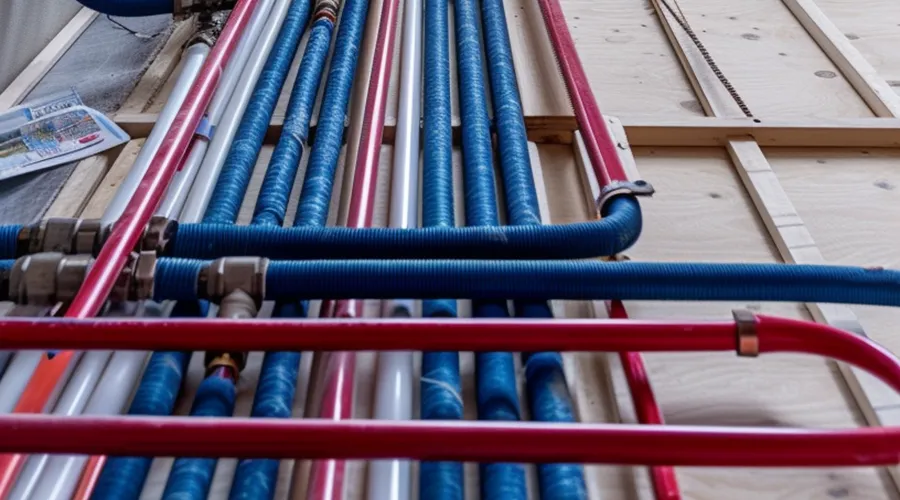Choosing pipe insulation materials is a crucial component in maintaining energy efficiency and protecting against freeze damage in residential, commercial, and industrial settings. Like a cozy winter coat for your pipes, proper insulation helps retain heat in hot water lines and prevents cold water pipes from freezing.
Insulating hot water pipes can increase water temperature by 2°F–4°F compared to uninsulated pipes, allowing you to lower your water heater temperature setting and save energy. This guide will explore the best materials for pipe insulation, helping you make informed decisions to optimize your plumbing system’s performance and longevity.
Why Pipe Insulation Matters
Pipe insulation serves two primary purposes: energy efficiency and freeze protection. By reducing heat loss in hot water pipes, insulation helps maintain water temperature, reducing the workload on water heaters and lowering energy costs. For cold water pipes, insulation prevents freezing in colder climates, protecting against burst pipes and costly water damage. Additionally, pipe insulation can reduce condensation, minimize noise from water flow, and even provide fire protection in some cases.
Best Pipe Insulation Materials
Foam Insulation
Foam insulation, typically made from polyethylene or elastomeric materials, is one of the most popular choices for pipe insulation.
Benefits:
- Easy to install
- Flexible and can be used on pipes with bends
- Good thermal resistance
- Moisture-resistant
- Relatively inexpensive
Drawbacks:
- May degrade over time when exposed to UV light
- Not suitable for very high-temperature applications
Fiberglass Insulation
Fiberglass insulation is a versatile option that can handle a wide range of temperatures.
Benefits:
- Excellent thermal performance
- Fire-resistant
- Can withstand high temperatures
- Durable and long-lasting
Drawbacks:
- Requires protective jacketing for moisture resistance
- Can be irritating to skin and lungs during installation
- More challenging to install than foam
Rubber Insulation
Rubber insulation, often made from elastomeric materials, is known for its flexibility and moisture resistance.
Benefits:
- Highly flexible, ideal for pipes with many bends
- Excellent moisture resistance
- Good for both hot and cold applications
- UV-resistant options available for outdoor use
Drawbacks:
- Generally more expensive than foam or fiberglass
- May have lower thermal resistance compared to other materials
Polyisocyanurate (PIR) Foam
PIR foam is a high-performance insulation material suitable for a wide range of temperatures.
Benefits:
- Excellent thermal performance
- Can withstand high temperatures
- Moisture-resistant
- Lightweight and easy to install
Drawbacks:
- More expensive than basic foam insulation
- May require additional fire protection in some applications
Selecting the Right Insulation Material
When choosing pipe insulation materials, consider the following factors:
- Pipe temperature: Match the insulation material to the operating temperature of your pipes.
- Location: Indoor or outdoor installation will affect your choice of material.
- Moisture exposure: Choose moisture-resistant materials for areas prone to condensation or water exposure.
- Fire safety: Consider fire-resistant options for high-risk areas.
- Budget: Balance initial costs with long-term energy savings and durability.
Installation Tips
To maximize the effectiveness of pipe insulation:
- Measure pipes accurately to ensure proper fit.
- Clean and dry pipes thoroughly before installation.
- Use appropriate adhesives and tapes for sealing joints and seams.
- Insulate valves and fittings in addition to straight pipe runs.
- Consider adding a vapor barrier for cold pipes to prevent condensation.
When to Seek Professional Help
While many pipe insulation projects can be DIY, consider professional assistance for:
- Large-scale commercial or industrial installations
- Complex piping systems with numerous bends and fittings
- High-temperature applications requiring specialized materials
- Situations where building codes or regulations must be strictly adhered to
FAQs
Q: How thick should pipe insulation be?
A: The thickness depends on pipe size, temperature, and desired efficiency. Generally, 1-2 inches is sufficient for most residential applications, but commercial or industrial settings may require thicker insulation.
Q: Can pipe insulation prevent freezing in extreme cold?
A: While insulation significantly reduces the risk of freezing, it may not completely prevent it in extreme conditions. Additional measures like heat tape may be necessary in very cold climates.
Q: How often should pipe insulation be replaced?
A: With proper installation, pipe insulation can last 20 years or more. However, inspect it annually for signs of damage or degradation, especially in outdoor or high-moisture areas.
Conclusion
Selecting the right pipe insulation material is crucial for maximizing energy efficiency and protecting your plumbing system. By considering factors such as temperature, location, and moisture exposure, you can choose the best insulation for your specific needs. Remember, proper installation is key to achieving optimal performance. Whether you opt for a DIY approach or seek professional help, investing in quality pipe insulation will pay dividends in energy savings and system longevity. Take action today to improve your pipe insulation and enjoy the benefits of a more efficient and protected plumbing system.



